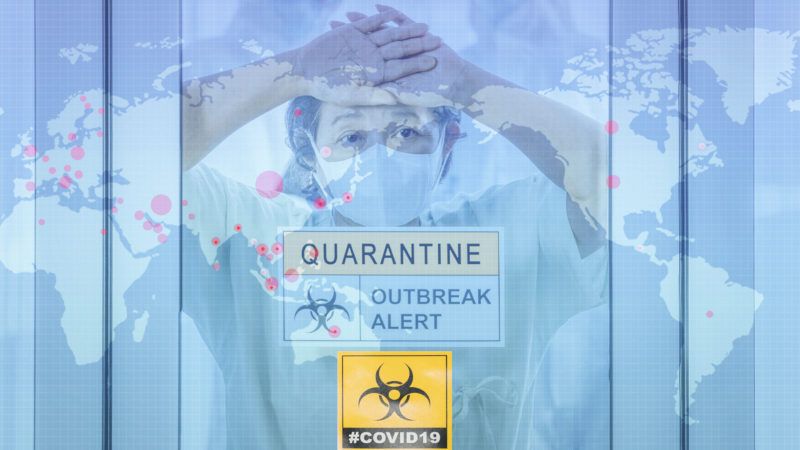Trump Says the COVID-19 Death Rate Will Be 'A Fraction of 1 Percent.' Is He Right?
It's too early to tell, but there are reasons for (relative) optimism.

President Donald Trump opined this week that the U.S. death rate from COVID-19 would turn out to be "a fraction of 1 percent." At least one authority—University of Pennsylvania vaccine expert Paul A. Offit—agrees. "I think he's right," he told FactCheck.org, adding that there has been a "wild overreaction" to the disease largely because it is new. "We're more the victim of fear than the virus," he said.
Are Trump and Offit right?
Confirmed novel coronavirus cases in the U.S. number around 250 so far, and 14 people have died of the COVID-19 respiratory disease caused by the virus. Crudely, these data would yield a truly frightening mortality rate of more than 5 percent. In contrast, the Centers for Disease Control and Prevention estimate that the current death rate from this season's influenza epidemic is between 0.05 and 0.10 percent. The global case fatality rate for the most severe pandemic in recent history, the Spanish flu epidemic in 1918, was between 3 and 6 percent; the rate was around 2.4 percent in the United States.
So are we facing an epidemic comparable to 1918 or something more like a severe flu season? "Globally, about 3.4 percent of reported COVID-19 cases have died. By comparison, seasonal flu generally kills far fewer than 1 percent of those infected," declared World Health Organization Director-General Tedros Adhanom Ghebreyesus earlier this week. According to the latest data, more than 100,000 cases of COVID-19 around the world have been confirmed, resulting in 3,408 deaths so far. Simple math yields the 3.4 percent death rate cited by Dr. Tedros.
If that's the right figure, then we're headed toward Spanish flu death rates. But before dousing yourself continually with Purell, note that the critical caveat is "reported" COVID-19 cases. Most experts believe the number of unreported cases is large. So far it appears that at least 80 percent of infected people exhibit mild or even no symptoms, and thus are unlikely to have come in contact with medical surveillance systems.
The fact that the U.S. lags in testing for the virus means that public health officials do not have a good idea of just how many Americans are already infected. That makes it difficult to estimate the disease's real mortality rate. In contrast, South Korea has been more aggressive, testing more than 140,000 people for the virus. Doctors there have confirmed more than 6,000 cases, yielding a fatality rate of 0.6 percent.
Interestingly, if the estimate that as many as 1,500 cases are currently undetected in Washington state, the 14 deaths (8 of whom were residents of the Life Care nursing home) reported there yields a case-fatality rate of just over 0.9 percent. Aboard the once quarantined Diamond Princess cruise ship, 707 passengers contracted the illness and so far 6 have died, yielding a death rate of 0.85 percent. That rate is unlikely to be representative, since COVID-19 is much riskier for older people and the ages of cruise passengers skew older.
A new report by researchers in Hong Kong estimate a symptomatic case-fatality rate of 1.4 percent. This is considerably lower than the WHO's 3.4 percent death rate. And again, it does not account for infected folks whose symptoms are mild or absent.
A preliminary modeling study by European researchers estimated that the undetected rate of coronavirus infection could be 20 times higher than the number of confirmed cases. If this is so, they write, that yields "a much lower mortality rate, which according to our computations is of the order of 0.15%." That would make the death rate for a coronavirus epidemic similar to that of a severe flu season.
One caution: A higher percentage of the population would be vulnerable to coronavirus infection, since flu epidemics are blunted by the fact that millions of us get our annual vaccinations. There will be no vaccine against this virus for at least 12 months.
"The best estimates now of the overall mortality rate for COVID-19 is somewhere between 0.1 percent and 1 percent," said Brett Giroir, an assistant secretary at the Department of Health and Human Services, at a press conference yesterday. The good news is that as more testing data comes in, the lower the mortality rate for COVID-19 falls.
Disclosure: As I report this, I am self-isolated with a bad cold which could well be caused by one of the four human coronavirus strains that are thought to be responsible for about 15 percent of adult common colds.
Show Comments (110)